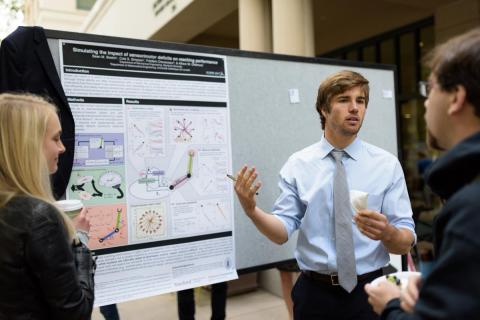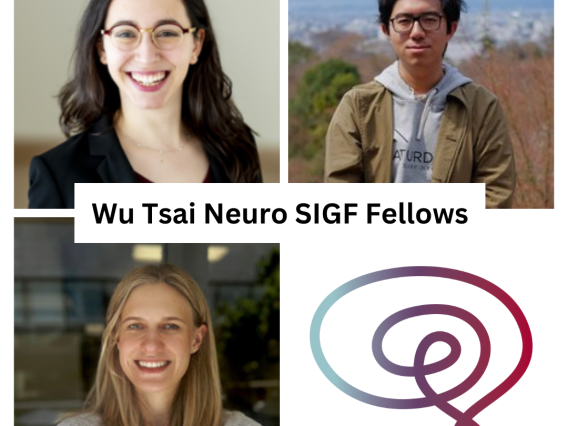Training the next generation of interdisciplinary neuroscientists
The Stanford Interdisciplinary Graduate Fellowship (SIGF) is a competitive, university-wide program that awards three-year fellowships to outstanding doctoral students engaged in interdisciplinary research. Three independent institutes, Bio-X, Wu Tsai Neurosciences Institute, and Sarafan ChEM-H award these graduate fellowships in the biosciences.
The Wu Tsai Neurosciences Institute partners with the Vice Provost for Graduate Education and Stanford BioX to award Stanford Interdisciplinary Graduate Fellowships (SIGFs) in the area of neuroscience. We are grateful to Bio-X and the Bio-X Leadership Council for incorporating the fellowships affiliated with the Institute into their application process.
Learn more about application details and eligibility criteria.
2025 SIGF Application
All applications submitted through the portal will be considered for the Stanford Interdisciplinary Graduate Fellowships (SIGFs) affiliated with the Wu Tsai Neurosciences Institute or Sarafan ChEM-H, the Bio-X SIGFs, and the Stanford Bio-X Bowes Fellowships.
Funded SIGF projects
Uncovering the neurochemical basis of colonic water absorption
Constipation and diarrhea, caused by aberrant water absorption in the colon, impose substantial health burdens. The enteric nervous system (ENS) harbors a specialized circuit for water absorption, the secretomotor/vasodilator circuit, but its role in the proximal colon remains poorly understood.
Uncovering behavior-dependent entorhinal maps with state space models
The medial entorhinal cortex (MEC), the brain’s “inner GPS”, contains an internal map of external space. Rather than representing a static spatial map, however, MEC neurons can spontaneously switch between multiple maps (Low et al., 2021). In this project, we will investigate if spontaneous map switches reflect changes in an animal’s latent internal state.
Uncovering the roles of representational drift in the brain through the lens of dynamical systems and their practical implications in brain-computer interfaces
Understanding representational drift—the brain’s evolving representation of its environment—is pivotal to gaining insights into neural computation. Despite its significance, the study of representational drift has been constrained by the scarcity of suitable datasets and methods.
Engineering objective physiologic measures to characterize nonmotor aspects of Parkinson’s disease
Parkinson’s disease (PD) is a complex, heterogeneous neurodegenerative disorder whose prevalence is increasing rapidly. Not only do patients experience motor symptoms, but many experience debilitating nonmotor symptoms caused by peripheral degeneration in the autonomic nervous system, including atrophy of the vagus nerve, and the enteric nervous system.
Determining higher-order organization of control and epileptic brain networks at single cell resolution
Dr. Darian Hadjiabadi aims to identify higher-order features of neuronal circuits responsible for seizure initiation and propagation by quantifying mesoscale-network reorganization in genetic models of zebra sh that faithfully recapitulate seizure dynamics in humans.
How do Schwann cells sort and myelinate axons in the developing peripheral nervous system?
Schwann cells (SCs) sort and myelinate peripheral axons, and impairments in either process can cause long-term disability. There are no therapeutic strategies for targeting SC dysfunction, underscoring the need to investigate mechanisms of sorting and myelination. Both processes require highly motile SC cytoplasmic protrusions, but the basis of this motility is unclear.
Design and development of a high-performance intra-cortical speech BCI
Many neurological injuries and diseases such as brainstem stroke and Amyotrophic Lateral Sclerosis (ALS) result in severe speech impairment, drastically reducing quality of life. Recent progress in brain-computer interfaces (BCI) has allowed these individuals to communicate, but performance is still far lower than typical spoken conversation speeds.
Geometric analysis and variability mapping in human white matter brain structures
Understanding the relationship between structure and function in the human brain is a key interest in neuroscience. In recent years the focus is turning to understanding the role of the white matter in human cognition, brain function and neurological disorders.





